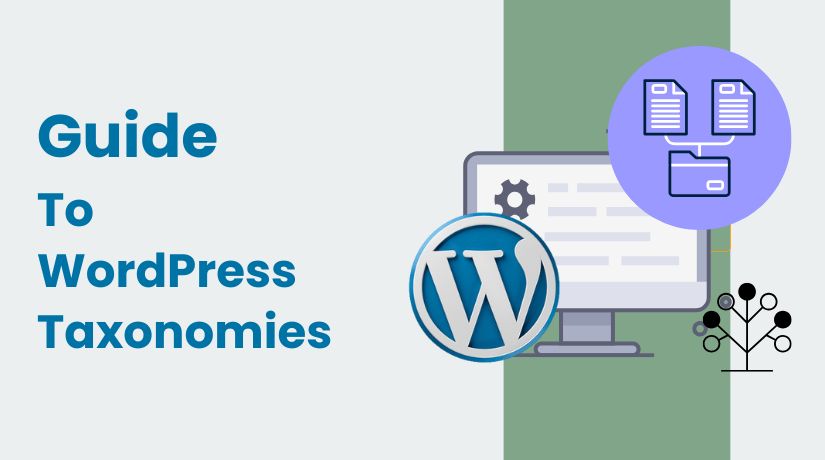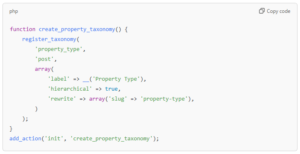
Table of Contents
- What Are WordPress Taxonomies?
- Types of WordPress Taxonomies
- How to Add Taxonomy in WordPress
- Practical Examples of WordPress Taxonomies
- Best Practices for Using WordPress Taxonomies
- Common Mistakes to Avoid
- Conclusion
- Frequently Asked Questions (FAQs)
WordPress taxonomies are tools for organizing content on your website. They help group posts, pages, and custom content. With taxonomies, users can navigate your site more easily. Categories and tags are default WordPress taxonomies. You can also create custom taxonomies for unique needs. This guide will explain WordPress taxonomies in detail. Additionally, it will teach you how to make and maintain them.
What Are WordPress Taxonomies?
WordPress taxonomies classify and organize website content effectively. They group similar posts or pages into meaningful collections. By default, WordPress support provides two main taxonomies: categories and tags.
Categories are hierarchical and used for broad groupings. A blog may, for instance, feature sections like “Health” and “Technology.” They enable you to systematically organise your stuff.
Tags are non-hierarchical and more specific than categories. They help label posts with related terms. For example, a post in the “Health” category might have tags like “fitness” or “nutrition.”
WordPress taxonomies improve your website’s navigation and user experience. Visitors can quickly find related content with properly organized taxonomies. They also improve search engines’ comprehension of your material. This improves SEO results.
Types of WordPress Taxonomies
Default Taxonomies
WordPress offers two main taxonomies: categories and tags.
Categories are hierarchical and organize content into broad groups. A blog discussing technology, for instance, may utilise categories like “Software” and “Gadgets.” These categories can have subcategories, such as “Mobile Apps” under “Software.”
Tags are non-hierarchical and more specific than categories. They add detailed labels to posts, improving searchability. For example, a post in “Software” can have tags like “Productivity Apps” or “Free Tools.” Tags allow users to find closely related content easily.
Custom Taxonomies
Custom taxonomies allow users to organize content based on unique needs. They are especially helpful for websites with complex structures.
For example, a real estate site might create taxonomies like “Property Type” or “City.” A recipe blog could use custom taxonomies like “Cuisine” or “Cooking Time.” These tailor-made taxonomies improve user navigation.
Creating custom taxonomies is easy and enhances website flexibility. They are ideal for e-commerce, educational, or niche content sites.
How to Add Taxonomy in WordPress
Using the WordPress Dashboard
You can add categories and tags through the WordPress admin panel.
- Open your WordPress dashboard and log in.
- To add a new category, click to Posts > Categories.
- Click Add New Category after entering the category name and description.
- For tags, go to Posts > Tags and follow a similar process.
Using Code to Create Custom Taxonomies
Creating custom taxonomies through coding offers more control.
- Open your theme’s functions.php file.
- Use the register_taxonomy() function to define the taxonomy.
- Here’s an example code snippet:

This code adds a custom taxonomy for property types. To view the changes, save the file and visit your website again.
Using Plugins
Plugins simplify creating and managing taxonomies. Tools like Custom Post Type UI and Toolset Types are user-friendly.
- Install the plugin and turn it on.
- Follow the plugin’s interface to define and configure taxonomies.
- Use taxonomies to group and display content effortlessly.
Plugins are ideal for non-technical users who want quick solutions.
Practical Examples of WordPress Taxonomies
Taxonomies are versatile and serve many website types effectively.
E-commerce Websites
E-commerce sites use taxonomies to organize products logically. For example, categories like “Clothing” can have subcategories like “Men” and “Women.” Custom taxonomies like “Brand” or “Material” improve product filtering.
News Websites
News sites often organize content by topics and regions. For example, a taxonomy for topics might include “Politics,” “Sports,” or “Technology.” Regional taxonomies like “Asia” or “Europe” make finding content easier.
Educational Platforms
Online course websites can use taxonomies for course types and levels. Examples include “Beginner,” “Intermediate,” or “Advanced.” Another example is using subjects like “Mathematics” or “Science.”
Recipe Websites
Recipe sites benefit from custom taxonomies like “Cuisine” and “Cooking Time.” These groupings make it easier for users to find desired recipes.
Custom taxonomies create a better user experience by improving navigation. They make websites more intuitive and user-friendly.
Best Practices for Using WordPress Taxonomies
Follow these tips for effective taxonomy management.
Use Categories Broadly and Tags Specifically
Categories should cover broad topics, while tags should be more detailed. For example, a “Travel” category might use tags like “Budget Travel” or “Luxury Trips.”
Plan Your Taxonomy Structure Carefully
Think about your website’s needs before creating taxonomies. Use hierarchical taxonomies when dealing with broad-to-specific content. Avoid cluttering your site with too many taxonomies.
Optimize Taxonomies for SEO
Ensure taxonomies have metadata for search engines. Add unique titles and descriptions to category or tag archive pages. Use taxonomies in permalinks for better content organization.
Avoid Duplicate or Overlapping Taxonomies
Don’t make taxonomies with the same function. As an example, don’t have a category and a tag for “Travel Destinations.”
Test User Navigation Regularly
Check how users interact with taxonomies on your site. Ensure that taxonomy filters and menus are intuitive and functional.
These guidelines can help you keep your website organised. Additionally, it enhances user happiness and SEO.
Common Mistakes to Avoid
Avoid these mistakes when managing WordPress taxonomies to improve performance.
Overusing Tags
Using too many tags can confuse users and reduce usability. Focus on a few meaningful tags to keep navigation simple.
Ignoring Custom Taxonomies for Complex Sites
Default taxonomies are not always enough for specialized websites. Use custom taxonomies to group content efficiently, like “Genres” for books.
Poor Planning of Taxonomy Structure
Not planning a taxonomy hierarchy can lead to a cluttered website. Think about your content’s organization before creating taxonomies.
Skipping SEO Optimization for Taxonomy Archives
Taxonomy archive pages need proper titles and meta descriptions. Ignoring these affects search engine rankings.
Duplicate or Similar Taxonomies
Do not create categories and tags with overlapping purposes. For example, avoid having a category and a tag both named “Travel.”
By avoiding these errors, you ensure a well-organized and user-friendly site.
Conclusion
WordPress taxonomies are essential for organizing and managing website content. They improve user navigation and make content easier to find. For the majority of websites, default taxonomies such as categories and tags are functional. Websites that are more specialised or sophisticated benefit grea tly from custom taxonomies.
Follow best practices to create and optimize taxonomies effectively. Avoid common mistakes like poor planning or overusing tags. Taxonomies also enhance SEO by organizing content for search engines.
To enhance your website, begin using WordPress taxonomy right now. They improve the professionalism and usability of your website.
Frequently Asked Questions (FAQs)
How are categories and tags different from one another?
Categories are hierarchical and used for broad topics. Tags are non-hierarchical and more specific.
Can I create multiple taxonomies for one post?
Yes, WordPress allows posts to belong to multiple taxonomies. Use this for better content organization.
Do taxonomies affect website performance?
Well-optimized taxonomies do not affect performance. However, overusing them might slow down large sites.
What plugins are best for taxonomy management?
Popular plugins include Custom Post Type UI and Toolset Types. These simplify creating and managing custom taxonomies.

